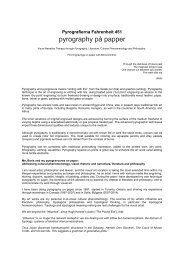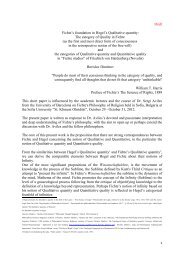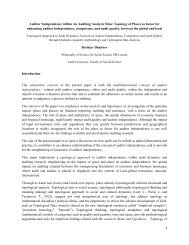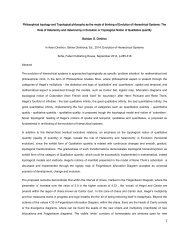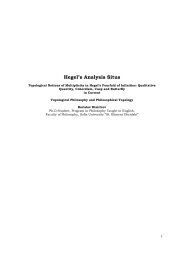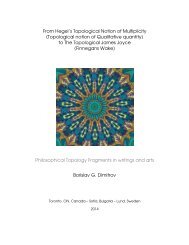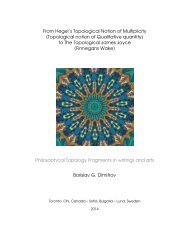Topological Ontology and Logic of Qualitative quantity
Qualitative quantity and BFO (Basic Formal Ontology) of /Barry Smith/ and YAMATO (Yet Another More Advanced Top-level Ontology) of /Riichiro Mizoguchi/
Qualitative quantity and BFO (Basic Formal Ontology) of /Barry Smith/ and YAMATO (Yet Another More Advanced Top-level Ontology) of /Riichiro Mizoguchi/
- No tags were found...
You also want an ePaper? Increase the reach of your titles
YUMPU automatically turns print PDFs into web optimized ePapers that Google loves.
inspected ``from the outside'', only for it to creep in from the back in the very act <strong>of</strong><br />
investigation.”<br />
The topological notion <strong>of</strong> Hegel’s logic contains the seed <strong>of</strong> topological hermeneutics with<br />
“genuine infinite, a circle closed on itself”<br />
…The infinite that wants to be unlimited, because as Hegel points out – “there are two<br />
worlds, one infinite <strong>and</strong> one finite, <strong>and</strong> in their relationship the infinite is only the limit <strong>of</strong><br />
the finite <strong>and</strong> is thus only a determinate infinite, an infinite which is itself finite." 117<br />
What the underst<strong>and</strong>ing should not forget is that these alternating determinations <strong>of</strong> the<br />
finite <strong>and</strong> the infinite are ultimately determinations <strong>of</strong> one unified something.<br />
<strong>Topological</strong> cobordis is just another dialectical <strong>and</strong> hermeneutical view on the betweennes<br />
<strong>of</strong> these two somethings – the finite <strong>and</strong> the infinite.<br />
9. Toward phenomenology <strong>of</strong> social topology through qualitative <strong>quantity</strong>: <strong>Topological</strong><br />
<strong>Ontology</strong> <strong>and</strong> … Social Topology <strong>of</strong> Pierre Bourdieu, the four divisions <strong>of</strong> the lifeworld or<br />
“the crux <strong>of</strong> Schütz” as topological structure <strong>of</strong> the Lifeworld, sociological hermeneutics <strong>of</strong><br />
Zygmunt Bauman, <strong>and</strong> A Levinasian Topology in Levinas’s 'Aborder Autrui’ (<strong>Topological</strong><br />
Trace in Levinas Trace …)<br />
In progress….!<br />
Abstract:<br />
This chapter will focus on sociology defined as “social topology” by Pierre Bourdieu, on the<br />
topological notion <strong>of</strong> sociological hermeneutics <strong>of</strong> Zygmunt Bauman, <strong>and</strong> in return back to<br />
the beginning <strong>of</strong> this paper <strong>and</strong> the term “topological ontology” will approach the domain<br />
<strong>of</strong> Huserls’s phenomenology <strong>and</strong> ontology trough the philosophy <strong>of</strong> Alfred Schutz who more<br />
than any other phenomenologist, attempted to relate the thought <strong>of</strong> Edmund Husserl to the<br />
social world <strong>and</strong> the social sciences. In this chapter the topological moments in Schutz’s<br />
Phenomenology <strong>of</strong> the Social World will be discussed as well as the possible topological<br />
approach to the phenomenology <strong>of</strong> the social world <strong>and</strong> ontological construction <strong>of</strong><br />
lifeworld. In Schutz’s “Phenomenology <strong>of</strong> the Social World”, we may find “Part 7.4 World<br />
Within My Reach <strong>and</strong> <strong>Topological</strong> Organization” [195(2)]. According to Schutz, there are<br />
four divisions <strong>of</strong> the lifeworld, that has been called 'the crux <strong>of</strong> Schütz's theoretical<br />
contribution. Can we use topology (topological philosophy or philosophical topology) to<br />
underst<strong>and</strong> Schutz’s idea <strong>of</strong> sharing “with me a community <strong>of</strong> space <strong>and</strong> a community <strong>of</strong><br />
time” Could we see the structure <strong>of</strong> the Lifeworld as topological structure <strong>and</strong> Schutz’s<br />
theory <strong>of</strong> relevance as topological homology<br />
The core atterntion in this chapter will be paid to <strong>Topological</strong> Trace in Levinas Trace,<br />
exploring the two main topological moments in phenomenology <strong>of</strong> Emanuel Levinas – the<br />
first s embedded in the idea <strong>of</strong> infinity <strong>and</strong> the second is encrypted in Levinas’s concept <strong>of</strong><br />
'Aborder Autrui’ – “To meet the Other is to have the idea <strong>of</strong> Infinity”. The metaphor <strong>of</strong><br />
topological cobordism will be used to co-bord the Levinas’ 'Aborder Autrui’,<br />
mapping out what J. Aaron Simmons calls “Vision without Image: A Levinasian Topology” 118<br />
117 Hegel's Science <strong>of</strong> <strong>Logic</strong>, trans. A. V. Miller, trans., Atlantic Highl<strong>and</strong>s: Humanities, 1990.<br />
Original German Text: Wissenschaft der Logik I, Frankfurt: Suhrkamp Verlag, 1970., 139-140.<br />
118 J. Aaron Simmons, "Vision Without Image: A Levinasian Topology," Southwest Philosophy Review 25, no.1<br />
(2009): 23-31.<br />
52





